Transfer Steps

Navigating Your Transfer Journey
Welcome, Transfer Friend!
We're so glad you're here! Whether you're just starting to explore or already have a clear transfer direction, we've outlined three steps in your transfer journey, along with key actions you'll take at San Diego City College to help you make progress toward your transfer goals.
You're getting ready to join the thousands of San Diego City College students who have transfered to CSU, UC, Private, Out-of-State, and HBCU colleges and universities.
And remember, you have a network of counselors, programs and resources to assist you along the way!
Are you ready? Let's explore!

New, first-time college students who began fall 2025 may be eligible for guaranteed admission through the CSU Transfer Success Pathway. Deadline to apply is October 31 each year! Attend a workshop for more information.
Step 1. Stepping In
Key Goals: Discover & Connect
Welcome to San Diego City College - a place many of us call home, and a community committed to your success. This phase of your transfer journey is about more than choosing a major or career. It’s a time to reflect, get to know more about who you are, what you care about, and what kind of future you want to build.
This phase focuses on exploration - getting to know yourself, your interests, your options, and your community college. Here, you’ll reflect on your goals, discover what interests you, and begin connecting with the people and programs that will support your success.
We’ve outlined five key action steps at this stage to help you get started. You may move through these action steps in your own way; each one is designed to support your growth and help you move toward transfer with clarity.
Expand the tabs below to explore the key actions you'll take in this part of your journey!
College isn’t just a new place - you're stepping in to a whole new system. Understanding what’s expected of you makes a big difference and can even impact how long it takes you to transfer. Your professors will expect that you understand the time commitment it will take to complete your assignments, the policies on adding and dropping courses, etc.

Learning the “college culture” means understanding how and where to ask for help, how to navigate deadlines, and how to show up for your own success.
To get started:
-
Review key semester and academic deadlines found in the class schedule and your mySDCCD portal.
-
Take a PERG 120 Course (College Success & Lifelong Learning)
-
Review your syllabi for each class carefully, writing down key assignments and deadlines
-
Work with your counselor to determine how many hours you need to study per week
-
Sign up for a time management workshop in the Tutoring Center.
We want you to navigate the transfer process as smoothly as possible. Explore the various programs that support transfer students early and find a community! To build your support network you may:
- Attend the Summer Transferpalooza Conference to connect with other new transfer students and transfer programs.
- Explore programs like Umoja, Puente, Hermanos Unidos Brothers United (HUBU), and the MESA Program.
- Ask your peers at the Welcome Center about their experiences navigating college, what programs they were part of, etc.
- Check in with a Counselor regarding programs and services that may support your goals.
College is a time when many students begin asking big questions like, “Who am I?” and “What am I doing here?” Dr. Dan Siegel, Professor of Clinical Psychiatry at UCLA, reminds us that identity isn’t fixed - we are always becoming. This allows us to have grace for where we are, and this makes your time here especially meaningful.
During your first semester (or even earlier), we invite you to explore what matters to you: your values, your interests, and your vision for the future. The more you understand about your “why,” the more grounded and confident you’ll feel as you make decisions about your major, career, and transfer path. Knowing your why can help you remain connected with your goals (or even "your purpose") when the journey feelings challenging.
To support this process, you may:
- Enroll in a Personal Growth course like PERG 120 or PERG 130 for a structured path toward self-discovery
- Spend some intentional time thinking about yourself, your future, and defining what success looks like to you.
- Journal about your goals, dreams and direction.
- Meet with a counselor to support self-exploration.
Please know that some students find it helpful to name their ‘why,’ while others find motivation in different ways.
Over the course of your first semester, or even your first year, you'll want to actively pursue this question: What kind of career do I want? To find this out, consider things that interest you, and that you're curious about. You may want to do some some self-exploration where you can examine your needs, values, interests, skills, strengths and personality type. You may wish to:
- Use the Career Center website and self-exploration tools.
- Meet with a counselor to discuss your career options.
- Enroll in a Personal Growth course like PERG 130: Career & Life Planning for a structured approach to clarifying your career objective.
Please know that it's okay to not have your career completely figured out! You're not "behind" if your career hasn't been decided.
Enjoy this time of exploration and remain open to discovering more about yourself and careers that may suit you!
Your major is the course of study that you will pursue in college. Some majors are career-specific, meaning they prepare you for a specific career, such as Nursing and Accounting. Other majors, like English or Psychology, are great foundations and can prepare you broadly for many careers. To identify your major you may:
- Explore majors available in the San Diego City College catalog.
- Explore majors available through Transferbound.com, the Princeton Review, majors at the California State University and the University of California.
- Do an informational interview with someone in your desired career field to see what major they studied to meet their career goals and what insights they have now.
- Meet with an academic counselor to explore majors. It helps to bring a few ideas with you, though it is not required.
Even if San Diego City College does not have your exact major, you can still plan for a successful transfer with the support of your counselor.
What are you looking for in your transfer university? Which colleges have your major? You'll want to narrow down your transfer options as you prepare to move into stage two of your journey.
To identify your transfer options, you may:
- Attend a Transfer workshop in the Transfer Center, or online.
- Research colleges and universities that have your major.
- Narrow down potential schools based on what matters most to you - cost, location, opportunities, fit, etc.
- Speak with university representatives at our Fall or Spring Transfer Fair. You may reach out to representatives any time with questions through our Explore Universities page.
Celebrate Your Progress!
Completing these action steps means you’ve laid a strong foundation for your transfer
journey. You’re now ready to Step Forward into the planning stage confidently.
Step 2. Stepping Forward
Key Goals: Prepare & Plan
In this part of your journey you'll focus on gaining information and awareness about transfer requirements so that you can effectively prepare and plan for the road ahead.
By now, you may have a one or two-semester education plan. Now it's time to step forward and meet with a counselor at San Diego City College to discuss and perhaps refine your transfer goals. Your counselor will help you develop a long-term, personalized education plan aligned with your major and target universities.
Expand the tabs below to explore the action steps that will help you get ready to transfer!

An important action step in the transfer process is creating an educational plan with a counselor.
An educational plan is a roadmap of classes that ensures you’ll be on track to meet the transfer requirements for your major at your chosen universities.
Your plan will outline the courses you need, including general education (GE), major preparation, and electives (if applicable), as well as a timeline for submitting your transfer application.
Your plan may also include recommendations to strengthen your transfer application and prepare for your career, such as taking honors courses, engaging in extra-curricular activities, internships, etc.
All counselors do transfer counseling! Meet with your counselor or contact the Transfer Center or General Counseling Department to connect with a counselor.
Start building relationships with your potential transfer schools.
Many universities provide opportunities for virtual advising for prospective students wanting to explore opportunities at their campus.
Local campuses like SDSU, UCSD, San Marcos and Point Loma Nazarene create time for students throughout the year for in-person transfer advising with Admissions Counselors.
Additional ways to connect:
- Attend our fall or spring Transfer Fair in October and April of each year.
- Connect with university representatives through virtual appointments or by sending an email.
- Create a CSU Transfer Planner or UC Transfer Admission Planner account for communication from your favorite schools and programs.
- Visit campuses in person through one of our university tours, on your own, or virtually.
- Join university webinars and workshops to learn about admissions, financial aid, and student life.
- Follow universities on social media to stay updated on deadlines and opportunities
Explore our events and workshops page for information on upcoming transfer visits and events.
Stay on track for transfer by completing the required coursework for your university and major. Transfer success depends on meeting general education (GE), major preparation courses, and GPA requirements, which vary by institution.
Most public colleges and universities in California require a minimum of 60 transferable units, including GE and major prep courses, for admission consideration.
Some students will complete the CSU General Education Breadth, IGETC or the Cal-GETC Pattern (new for students beginning fall 2025 or later) in order to meet general education requirements.
Celebrate Your Progress!
You’ve taken key steps to prepare and plan for your transfer journey. Now, it’s time
to Step Through to the final stages of this journey - applying, making decisions, and getting ready
for your next chapter!
How to Transfer to a CSU How to Transfer to a UC
Step 3. Stepping Through
Key Goals: Apply, Decide & Transition
This is the final phase of your transfer journey, where you apply, decide, and prepare to transition to the university. It’s an exciting time filled with opportunities and big decisions and, with the support of a counselor, and other significant people in your life, you’ll finalize your transfer plans, submit your applications, and prepare for your transition.
Expand the tabs below to explore the key actions you'll take to make transfer happen!
It’s time to apply!
Complete and submit your applications for CSU, UC, private colleges, HBCU's, and out-of-state universities by the published deadlines. Not sure of your application deadline? Review the notes from your counselor on your education plan or check in with the Transfer Center in room A-301.
Be sure to double-check your application for accuracy prior to submission.
We recommend attending an application workshop - either through the Transfer Center or your prospective university - and attending a Transfer Application Lab for support with your application.
Once you submit your application, check your email regularly for important information and to-do items from your schools. Many of these items will have deadlines so please check your email often.
The Transfer Center offers "Next Steps" workshops each December to help you understand what comes after your application is submitted. In these workshops you will:
- Learn what to expect after you apply
- Understand important deadlines that follow the application
- Know when and how admissions decisions are typically released
Most City College transfer students are eligible to earn a certificate or degree prior to transfering, including the Associate Degree for Transfer (AA-T, AS-T).
We encourage students to apply for graduation one semester prior to the anticipated graduation term (i.e., spring graduates are encouraged to apply during the fall semester prior.)
If you're uncertain whether or not you're eligible for graduation, please make an appointment with your counselor or visit the Transfer Center.
Note: Students who apply for graduation are not required to participate in the commencement ceremony.
Maximize your opportunities to make college affordable by submitting a FAFSA or California Dream Act Application (CADAA) by the priority deadline of March 2.
You are encouraged to submit your application as early as possible. The FAFSA and CADA applications typically open on October 1 of each year.
Explore scholarship opportunities at San Diego City College, through external organizations, and at your transfer university. Visit our Grants & Scholarships page for information about scholarships.
Many universities require that students apply for financial aid in order to be considered for a scholarship. You are encouraged to apply even if you don't think you qualify.
Once you receive your admissions offers, take some time to compare financial aid packages, review the academic programs, and campus resources to make an informed decision.
If you’re on a waitlist, get informed about your next steps.
If you weren’t admitted to your top choice, ask your counselor whether or not an appeal is appropriate for your situation.
The Transfer Center is here to support you - no matter what admissions decisions you receive.
It's time to get ready for your next chapter!
Check your university portal so that you submit the following on time:
- Statement of Intent to Enroll/Register (typically by May 1 for CSU; by June 1 for UC)
- University fees
- Official Transcripts (multiple may be required)
- Housing application
- Immunizations
- CSU GE/IGETC/Cal-GETC Certification
- AP/IB scores, etc
- Etc
Many schools offer workshops for admitted students in the spring so that you understand what is needed to make a successful transition. Review the Transfer Center calendar or our events page for admitted students workshops in the spring.
Be sure to attend all admitted student events and orientations for transfer students found on your respective school's website, and meet with an academic advisor at your new university!

You did it!
Now’s the time to seek out campus programs and connect with your new university’s Transfer Center. Most campuses have one - and they often offer events, resources, and support specifically for incoming transfer students like you!
Building community early can make your transition that much smoother. Find information for some of the university transfer centers below:
- CSU San Marcos Transfer Programs
- Point Loma Nazarene Transfer Services
- SDSU Transfer Student Success
- UC Berkeley Transfer Student Center
- UC Davis Transfer & Reentry Center
- UC Irvine Transfer Services
- UCLA Transfer Student Center
- UC Merced Transfer, Returning & Veteran's Student Services
- UC Riverside Transfer Success Program
- UCSD Triton Transfer Hub
- UC Santa Barbara Transfer Center
- UC Santa Cruz Transfer Services
- USD Torero Hub
Celebrate Your Achievement!
You’ve reached the final stage of your transfer journey - what an accomplishment! No matter the outcome, your hard work, planning, and persistence have brought you to this very imporant step. Whether you’re moving forward with an admission offer or figuring out your next steps, be proud of how far you’ve come. Your journey is still unfolding, and new opportunities are ahead!
General Timeline for Fall Transfer Students*
August
Access the UC application
Work on your UC Personal Insight Questions
September
Submit your UC TAG application (by the September 30th deadline)
Oct. 1st–Nov. 30th
Submit your UC Application and/or CSU application(s) (December 1 is the deadline for fall 2026.)
January
Complete the UC Transfer Academic Update and/or Academic History Update (CSU) by January 31st. Note that some schools may have a Supplemental application due in January (CSULB, SJSU, and others).
March
Admission notifications begin
Housing contracts become available
Housing: Since campus housing is highly impacted and assigned first-come, first-served, it is recommended that you submit your Statement of Intent to Register (SIR), housing contract or application, and first housing payment as early as possible.
May 1
CSU Deadline to submit your Intent to Enroll, and transcripts if requested.
SDSU Transfer Admission Timeline
June 1
Deadline to submit your UC Statement of Intent to Register (SIR) and other documents as required.
UC Transfer Admission Dates & Deadlines
June 30
Deadline to submit your final transcripts/documents for coursework completed through end of spring
July 15
IGETC Certification, AP/IB scores due to the UC
September
Fall Quarter/Semester begins
*This is a general transfer timeline. Some campus timelines may vary. Please check your specific campus for exact deadlines.
